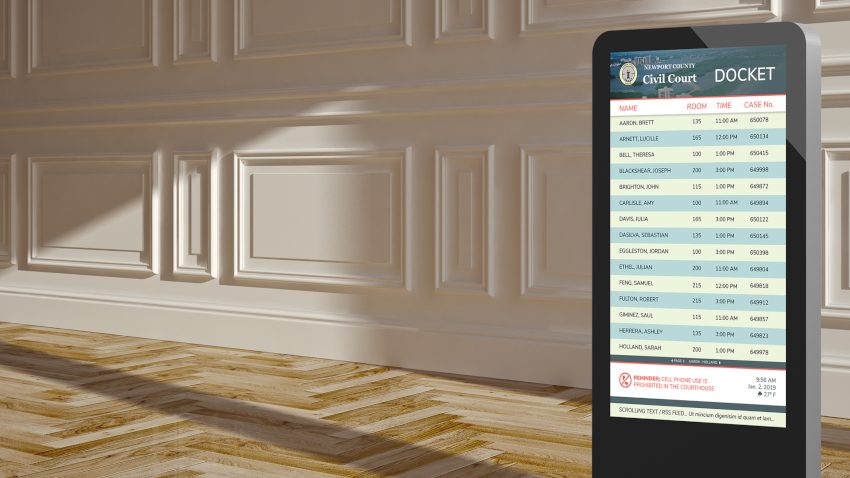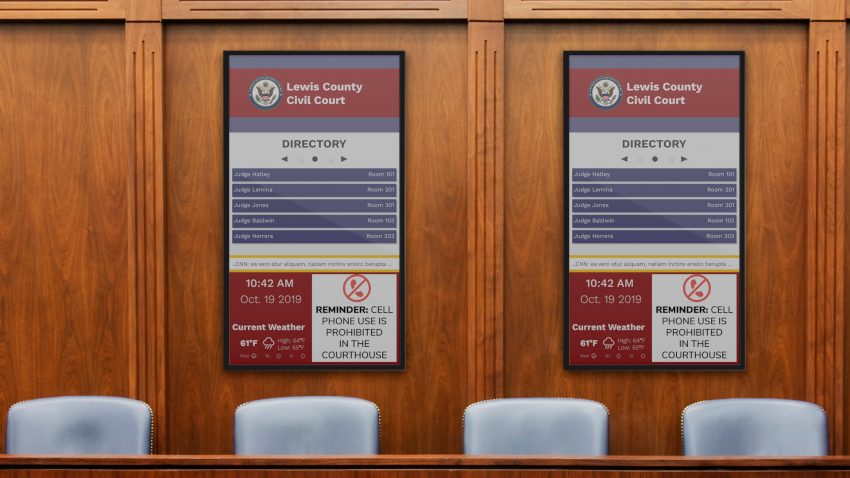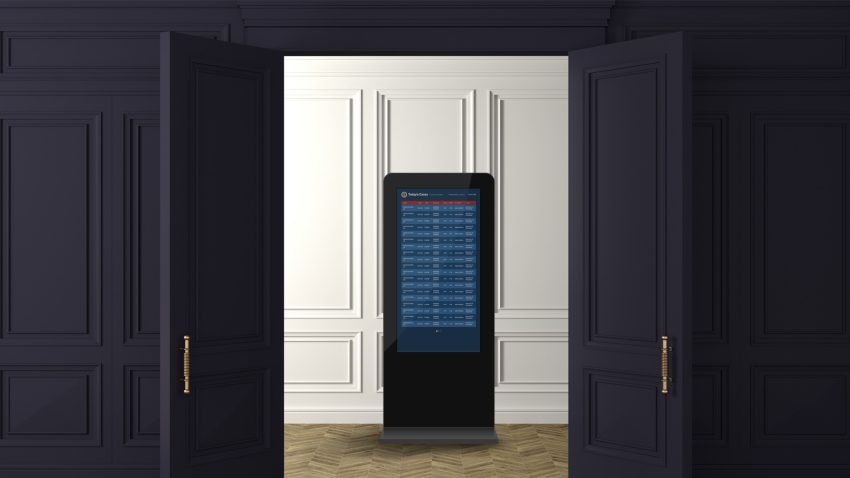What are Court Docket Displays and Why Do Courthouses Need Them?
When a person has a court date in a family law issue, their case is most likely placed on a docket. Many courts have embraced court docket display technology since people tend to retain 65% of visually transmitted information.
A docket is where there are multiple cases set at the same time. Some cases on a docket are set for status or scheduling issues. This means the court wants a status of where your case is at in terms of outstanding discovery issues, settlement negotiations, and the procurement of expert reports. In other situations, the court has various motions set on its docket.

For instance, there could be cases with motions involving discovery issues or requests for mediation. Some cases on a docket are set for hearing. For example, there could be temporary custody hearings.
If you have a court date in your case and are on a docket, it’s important to know where your case is on the docket. Determine your position on the docket. Are you number one on the docket or the 50th case on the docket? Digital signage technology has made finding this information easy. Here is all you need to know about digital court docket displays.
What Is a Court Docket Display?
Digital court docket displays are convenient for busy courthouses where they help streamline communication processes. These systems display real-time case information, including case numbers, the persons involved, the courtroom, and time.
Mvix court docket display works through a docket widget. Each display costs $10 per month. The docket widget acquires case information from a docket database and arranges the information in a format that is easy to read. Consequently, the system displays the information on a screen. Whenever there is an update on the docket database, it’s immediately reflected on the display system.
Apart from names, courtrooms, case numbers, and time, court docket displays also show attorney information, a description of the court hearing, and the presiding judge. The system also allows clerks to show custom information specific to their court. For example, a clerk can modify the display to show the names of police officers involved in the case.
How to Measure the Value of Court Docket Displays
Like any organization, courthouses must justify the cost of new technologies like court docket displays. However, the real ROI of courtroom digital signage isn’t determined by profit margins. It’s an intangible qualitative measure. The qualitative benefits of court docket displays are better understood with the following questions:
- Will it enhance the visitor experience?
- Will it improve communication?
- Will it boost staff productivity?
- Will it improve operational efficiency?
These considerations are essential in the courtroom environment’s mood, performance, and success.
Benefits of Digital Court Docket Displays
Court docket displays have slowly gained recognition in many courts. Courts are shifting away from static messaging and adapting digital communication technology. Along with displaying court information easily and keeping visitors informed, digital docket displays come with the following benefits.
1. Reducing Labor
Many visitors in courtrooms often ask court clerks for directions. For instance, a visitor may inquire about the location of a specific courtroom. In the past, court visitors would queue at the clerk’s office to ask about different aspects of their case. Clerks had the burden of determining a visitor’s case type and the district court they were to go to, among many other things.
One of the benefits of court docket displays is to lighten the clerks’ workload by displaying a map of the building and circuit courtroom numbers.

Additionally, these digital displays also improve security checkpoints. This means staff doesn’t have to spend time explaining security protocols and instead can focus on more productive tasks. Digital signage also relieves the court staff of the task of answering questions about emergency exit locations and dress codes.
2. Saving Resources
A significant benefit of the digital court case management system is the savings achieved. In fact, according to a study by McKinsey Global Institute, properly positioned, configured, and designed digital signage can improve productivity by 25 percent. This translates to millions or billions saved in lost productivity.
Static messages take time to update. Imagine having to update the information of hundreds of cases daily. Furthermore, static updates are costly regarding the expenses incurred for papers and printing. On the other hand, court docket displays require less work and are easy to update.
Courtrooms need to post the daily itinerary for ease of reference to visitors. With the docket display apps, clerks can upload daily dockets using XML, CSV, or JSON file formats and select the appropriate date range. Additionally, clerks can edit and display schedule changes without having to print or manually edit static signage. Consequently, it’s easy to update information quickly, which is immediately reflected on the court docket display systems.
3. Advanced Scheduling
Digital docket displays have advanced features for scheduling content. As a result, clerks can play content at specific times or days. Moreover, clerks can set the content to repeat on certain days. The courts should deliver dynamic content that engages their audience and keeps them informed. Many court docket displays feature content like:
Court Dockets
Think of how much a docket display can ease a confused visitor’s mind. The presentation helps the visitor go to the right place at the right time. Visitors can double-check information regarding their case with a single glass at the digital signage screen. In the past, visitors had to run a case search to generate basic information like the court calendar and their position on the court docket.
Courthouse visitors seek information that guides them regarding court hearing times. Also, the visitors want to know the hearing room locations. The dockets display updated information on case numbers, judge names, and the hearing room locations. When court visitors are comfortable, legal proceedings run more smoothly than when they are anxious and unsure about their case information.
Local Information
The court docket displays also show local news. This includes weather forecasts, upcoming events in the area, and up-to-date traffic updates. The local information on court docket displays helps engage local visitors and gives them a chance to adjust their plans accordingly.
Information Cards

Digital court docket displays also show crucial information that helps visitors abide by the court rules and regulations. The information cards contain information like education on policies, dress code, rules of conduct, and security checkpoint procedures.
Users can create a personalized template for each piece of information that is set to rotate and update automatically. These templates can be informal or formal, depending on the personality and identity of the courthouse in question. A lighthearted informational slide can improve a visitor’s experience. So, when viewers see information content that is inviting, warm, and funny, their experience is less of a faceless bureaucracy and more of personal interaction between themselves and the courtroom staff.
Wayfinding
A significant benefit of the court docket display is wayfinding information. This helps visitors find the nearest exits. Additionally, visitors get a visual of what to expect on each floor of the courthouse.
Emergency Alerts
Disasters and incidents happen when you least expect them. In a courtroom setting, visitors must know how to respond to emergencies.
Alerts like gas leaks, fires, and national disasters need urgent attention. The court docket displays present real-time safety information in case of an emergency. For example, a customized digital signage app can show maps of the courtroom’s emergency exits in case of a fire. Moreover, the signage app can direct users to storm shelters during hurricanes or tornadoes.
Social Media
Digital signage and social media are two platforms that are effective at capturing consumer attention. Actually, one study established that 72% of the world’s population is on at least one social platform. This is the reason even court docket digital signage solutions accommodate social media.
Therefore, considering the large number of people who turn to social media for information on court proceedings and case updates, many courts have a social media page. Courthouses with a social media page can display their social wall on the docket signage to inform and engage visitors.
4. Improve Customer Service
The Millennials and Generation Z population like acquiring information independently. One of the benefits of court docket displays is to promote self-service. Through kiosks, visitors have access to various self-service options. This enables them to get answers to their queries and receive public notice updates.
5. Queue Management
Another significant benefit of court docket displays is queue management. Many court visitors join queues without any idea of when their turn will come or whether they are in the right queue.

Court digital displays show queue information. As a result, you know your estimated waiting time and can track who is next in line. This information is helpful because it helps visitors adjust their schedules depending on how long they have to wait for their turn.
Improve Courtroom Experience With Court Docket Display
Digital technology has led to the rise of smart devices, smart corporations, and smart courtrooms. Court docket display signage is one of the first steps for traditional courthouses moving into the digital age. Using strategically-located signage displays and customized applications enhances the visitor experience and improves communication and productivity in the courtroom.
Nothing is frustrating for a courthouse visitor like misinformation or lack of sufficient information. The bureaucracy involved with court cases often disheartens many court visitors. When visitors are updated with all the information about their cases, they are less tense and more high-spirited. This is attainable through appropriate digital signage solutions in the courtroom.
Digital signage benefits not only the court visitors but also employees and judges at the court. From reducing labor to advanced scheduling, court docket signage has proven effective in improving courthouse activities and experiences.



